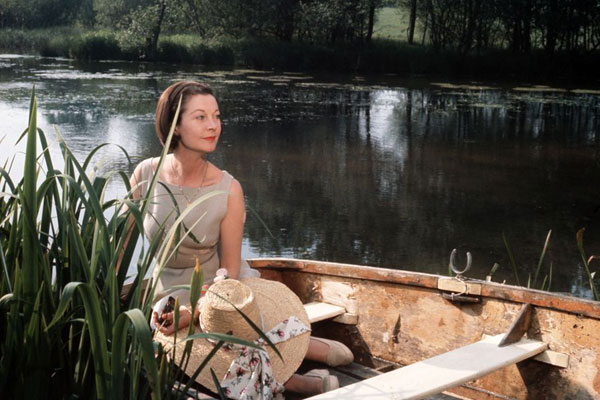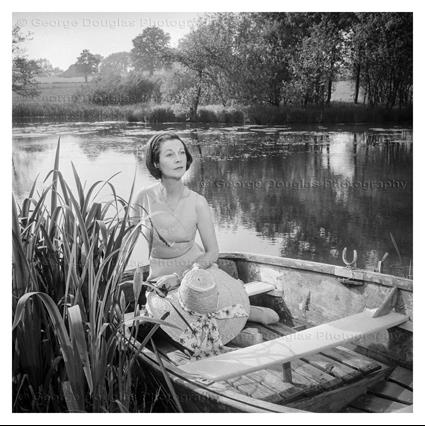2014 has been a wonderful year for Vivien Leigh, and the train is showing no signs of stopping. Just a couple weeks ago (December 5-7), London-based organization Fashion & Cinema hosted an event titled Dressing Vivien Leigh, which focused on – you guessed it – Vivien Leigh and her relationship with fashion, particularly costume design.
I was over the moon when my agent forwarded me an email from the organizers of Fashion & Cinema inviting me to introduce the two films they’d lined up for the weekend. Since Vivien Leigh: An Intimate Portrait was published, I’ve jumped at any opportunity that’s come my way. Not only do I feel like these speaking engagements help me build up a portfolio of experience, they also help me on my quest to get over an irrational fear of public speaking. I feel less nervous each time I do it. So thanks for letting me use your microphones, past and future event planners!
Dressing Vivien Leigh kicked off on Friday December 5 with a fantastic lecture at the V&A. I always enjoy listening to curator Keith Lodwick speak about the treasures that he oversees in the V&A’s Theatre and Performance collection. His enthusiasm is so engaging. This was the third or fourth time I’ve seen him speak and each time I come away from it feeling like I’ve learned something new.
Keith delved into Vivien’s relationships with a handful of costume designers – notably Oliver Messel, Beatrice (Bumble) Dawson, and Roger Furse. He also spoke about past exhibitions that included Vivien-related materials, such as Hollywood Costume (now in Los Angeles), and gave us all a treat by revealing never-before seen color photos taken with Vivien’s stereoscopic camera. And of course tongues started wagging when Keith revealed that the Vivien Leigh Archive is currently being catalogued and will be open to researchers in January. If you’re looking for me, I’ll be at Blythe House!
 Introducing Streetcar with Tennessee Williams biographer John Lahr at Cine Lumiere in Kensington
Introducing Streetcar with Tennessee Williams biographer John Lahr at Cine Lumiere in Kensington
I was thrilled to take part in both film screenings on December 6 and 7. Tennessee Williams biographer John Lahr and I spoke off the cuff when introducing A Streetcar Named Desire, and I had a talk prepared for the Roman Spring of Mrs Stone screening at Ham Yard Hotel in Soho on Saturday the 6th. Fashion & Cinema organizers Joanna Sanchez and Diana Maclean did a great job choosing the venues for these screenings and there were pretty good sized crowds at both of them. In fact, I was happy to see some familiar faces (Terence Pepper and Clare Freestone from the National Portrait Gallery, my agent Laura Morris, fellow film fans Anthony Uzarowski, Katie Sawyer, Alejandro Pappalardo), and it was a bit surreal chatting with Vanity Fair UK‘s online fashion editor Emma Marsh.
 Introducing The Roman Spring or Mrs Stone at Ham Yard Hotel in Soho
Introducing The Roman Spring or Mrs Stone at Ham Yard Hotel in Soho
I thought Roman Spring was an interesting choice for a screening because it’s not one that people talk about very much where Vivien’s career is concerned. Often overshadowed by her Oscar-winning turn as Tennessee Williams’ wounded butterfly Blanche DuBois, Karen Stone, and the film itself, tends to divide audiences. But it is an interesting film in the context of Vivien and fashion. Here’s what I had to say about it (let it be said that it was more difficult than I had thought to contextualize an entire film in 15 minutes):
The Roman Spring of Mrs. Stone, based on the novella of the same name by Tennessee Williams, is the story of a middle age actress who suddenly finds herself too old to play the ingénue roles that made her famous. She decides to flee the profession, settling in Rome following the death of her husband. She takes a palazzo near the Spanish Steps and there, with only the cold comforts of her late husband’s “filthy millions,” she begins to drift – to move through life and through the ageing process alone and without reason. This, according to Karen Stone, was the worst thing that could happen. In her loneliness, she meets with Contessa Magda Terribbli-Gonzales, who introduces her to a gorgeous young Italian called Paulo. She falls in love, but in typical Tennessee Williams fashion, the union isn’t exactly a happy one.
Vivien Leigh actually wasn’t the first choice to play Karen Stone. Williams had Greta Garbo in mind while he was writing the book. But, as is typical in Hollywood, it was some years before the film version went into production. By 1960, Garbo was deep in seclusion in New York. Screenwriter Gavin Lambert later wrote about how Vivien came to play the title character: “While I was working on [the script], various people suggested actresses for the part, but none of them seemed right to Tennessee Williams, or to the director Jose Quintero, or myself. Then, one day, Tennessee said, ‘Vivien must play it.’ We immediately realized she was ideal. Why hadn’t anyone thought of her before?” The reason for this was probably because it had been five years since Vivien last appeared on screen. This was actually typical in her career. She preferred the stage to the screen, although her previous successes, particularly Gone With the Wind, had kept her firmly on top of the star ladder.
It was a risk to cast her. While filming Elephant Walk for Paramount in 1953, Vivien had a nervous breakdown and had to be replaced by Elizabeth Taylor. She was thereafter considered uninsurable – a liability- by producers. But she was a guaranteed box office draw, and for independent American producer Louis de Rochemont and first-time director Jose Quintero, a name like Vivien’s was worth the gamble.
Vivien initially refused the role. She said of Tennessee Williams, “For myself, I don’t believe there’s anyone writing today who can illuminate the soul of a character with greater clarity or greater compassion.” Their relationship dated back to 1949 when she starred as Blanche DuBois in the London stage production of Williams’ Pulitzer-winning play A Streetcar Named Desire, and she won her second Oscar for bringing Blanche to life on screen in 1951. Vivien once told a reporter she’d play in anything Williams wrote, with the exception of Suddenly, Last Summer. She had been considered for the role of Violet Venable in the 1959 film, a part eventually played by Katharine Hepburn. It wasn’t Karen Stone’s story that put her off, but rather Williams’ description of her degradation, which Vivien considered “cruel” and “grotesque.” Only after reading Lambert’s screenplay did she change her mind and accept. Part of her reasoning seems to have been the chance to make a film in Rome. However, owing to anger over La Dolce Vita, Federico Fellini’s recent portrayal of decadence in the Italian capital, the production company was forced to abandon their on-location plan and film most of The Roman Spring of Mrs. Stone at Elstree Studios just outside of London.
There were perks for Vivien, though. While her friend Beatrice Dawson designed the costumes for the rest of the cast, Vivien’s star power allowed her to go to Paris to be dressed by her favorite real-life fashion designer, Pierre Balmain. We don’t typically think of Vivien as a fashion icon. She was known for being well dressed and fashion forward in public, but she didn’t have a particular connection with any one designer like Audrey Hepburn did with Givenchy, for example. But any regular reader of Vogue or other fashion magazines between 1936 and 1960 would have come across Vivien frequently posing for Cecil Beaton, Norman Parkinson, and Clifford Coffin, in gowns by Victor Stiebel, Elsa Schiaparelli, Molynoux, Hardy Amies, and Dior, to name but a few.
The costumes she wears as Karen Stone befit the character, described by Williams as glamorous where she was once beautiful. Karen starts her life in Rome wearing well-tailored, classic black. Later in the film, when Karen is in the honeymoon stage of her affair with Paulo, she takes on a more youthful look with a pixie haircut, pastel colors, light fabrics, and Grecian draping. Still later, when Karen accompanies Paulo to a busy restaurant, she sits in a corner wearing a heavy gold silk with lots of jewelry. This scene in particular is pivotal to the story because into the restaurant comes plucky American starlet Barbara Bingham (played by future Bond girl Jill St John), surrounded by paparazzi. Paulo gravitates toward her and Karen has a flash of self-realization: her glamour and money might not be enough to hold a young man like Paulo when there are plenty of younger fish in the sea. The age factor is a very literal element in this film. We are constantly reminded through dialogue and lighting that Karen is no longer a kitten but a full-fledged cougar. The cinematographic and costume techniques used to make Vivien appear younger didn’t sit well with some people.
I have a letter here that I’d like to read. It was written to LA Times gossip columnist Hedda Hopper by a Vivien Leigh fan called Jane Harris from Statten Island, New York on February 20, 1962:
Dear Miss Hopper:
I have just seen “Roman Spring of Mrs Stone” starring my favorite actress Vivien Leigh and newcomer Warren Beatty and had to write to tell you how unfair I think the camera work was to Miss Leigh’s beautiful face.
I realize a great many years have passed since she enchanted audiences with her rare beauty and acting ability as Scarlett O’Hara, but having seen her just two years ago on stage here in N.Y., I know what a beauty she still is. This picture made her look just terrible, and I’m surprised at Warner Brothers for the unfair close-ups of her, she looked so sickly and white, it hardly even resembled her. Why they didn’t let her keep her hark hair I’ll never understand, the ash blonde color even made things even worse, and she looked so much older than she really is. Miss Hopper, I hate to bother you, but you’ve always been my favorite movie columnist, and I’m sure you agree with me that something should be done to assure these well-known actresses that the cameramen will do their best to make them look as good as they can instead of making them look as bad as they can I’m so disgusted with the outcome of this movie, and I hope that the next time Miss Leigh appears on the screen she’ll look as beautiful as she does off-screen instead of like some old hag. I also think it’s a shame that such a fine actress has to degrade herself by playing in Tennessee William’s trashy stories.
If Warner’s was trying to make Vivien look like a very old and very unattractive Mrs. Stone, believe me, they more than succeeded.
But being close to movie people, I hope that you’ll be able to tell the heads of Warner Bros. not to bother starring Vivien Leigh in anymore movies unless they can photograph her as the beautiful star she is instead of as someone’s great Grandmother, what a blow to such beauty and talent.
After seeing some of the so-called new stresses on the screen today, I know why Vivien Leigh is still, and will always be my favorite star, there never was an never will be a greater star on the stage or on the screen, and as for beauty, in her day she was more beautiful than Liz Taylor, Suzy parker, and Marilyn Monroe put together.
I hope something will be done in the near future to protect other stars from the humility Miss Leigh must have suffered because of this film, the photographer should be hung from his toes on Hollywood and Vine.
This letter is really interesting because it illustrated conservative attitudes toward Tennessee Williams’ work at the time, as well as a conundrum that Vivien faced throughout her career, which was attempting to make people take notice of her talents as an actress rather than focusing on her beauty. It was extremely difficult for film stars to break away from their set images generated by producers and audience feedback. Take Ava Gardner, for example. Like Vivien, she was known for her stunning looks, and as a consequence she was never taken very seriously by critics, or given much of a chance by her colleagues at MGM to improve on her talents. Vivien, on the other hand was taken a bit more seriously as a film actress, particularly in America, but audiences were very resistant to accepting such drastic changes in looks and character. While filmgoers like Jane Harris of Staten Island decried what they saw as degrading treatment of a star, Vivien was actually happy to don tatty wigs and unflattering make-up if she felt it would help convey the character she was playing. This was most noticeable in A Streetcar Named Desire, but we also see it here.
What interests most about The Roman Spring of Mrs. Stone are the similarities between Vivien and Karen Stone. While this is in no way meant to detract from the work she put into her performance, however knowing what we do about Vivien’s life, it’s difficult not to draw parallels between actress and character. When this film was released in 1961, Vivien was approaching 50 and had just gotten a divorce from her second husband and long-time collaborator, Laurence Olivier. The event made headlines around the world and along with it, speculation of how Vivien was facing the future alone. What fans at the time were really interested in was how she was going to get along in life and work without Larry by her side. He married the much younger actress Joan Plowright. Was Vivien destined to drift through middle age alone? Plot twist – she was with a younger actor called Jack Merivale from 1960 until the end of her life so she wasn’t alone and drifting per se, but she was frequently cited as being lonely. And even Vivien, who had spent the majority of her career on the stage, was not immune to the perils of growing older in the business. “What’s happening,” she noted in 1960 “is that roles come few and far between when an actress gets older. In the past, and particularly in London, producers, playwrights, and directors would think nothing of casting a woman in her forties or fifties to portray a heroine in her twenties. These days age has become such a factor.”
And she wasn’t alone. Think of actresses like Bette Davis or Joan Crawford who took to playing grotesque parodies of their former selves in horror films – Robert Aldrich’s Whatever Happened to Baby Jane? is a classic example of this trend. While Vivien never quite reached that level of shock value, I think she was brave for tacking a role that reflected what was considered a rather sad and perilous time in many actress’ lives and also, in particular, in her own life. Critics agreed. While many thought the subject matter and plot depressing, Vivien was praised for bringing dignity, glamour, and most importantly, believability to a character that was largely unsympathetic. It was hoped that this film would mark the start of a new career for Vivien on the American screen. Unfortunately, she only appeared in one more film before succumbing to tuberculosis in 1967 at age 53. But just think of the potential.
 With Fashion & Cinema’s Diana Mclean before the Roman Spring screening
With Fashion & Cinema’s Diana Mclean before the Roman Spring screening
 We sold some books! Waterstones did a good job of displaying copies of Vivien Leigh: An Intimate Portrait in the lounge area at Ham Yard
We sold some books! Waterstones did a good job of displaying copies of Vivien Leigh: An Intimate Portrait in the lounge area at Ham Yard
 Fans lined up to get into Streetcar at Cine Lumiere
Fans lined up to get into Streetcar at Cine Lumiere

 Copies of Vivien Leigh: An Intimate Portrait and Tennessee Williams: mad Pilgrimage of the Flesh on display at Cine Lumiere.
Copies of Vivien Leigh: An Intimate Portrait and Tennessee Williams: mad Pilgrimage of the Flesh on display at Cine Lumiere.
The audiences seemed to largely enjoy both screenings and I was able to meet some interesting people, including an elderly woman who said she purchased a copy of my book as a Christmas present for her sister who has been a lifelong Vivien Leigh fan. As children, she said, her family lived in Alexandria, Egypt. When Vivien Leigh came to town during the Old Vic Spring Party organized by ENSA in 1943, the two sisters went to her hotel and knocked on the door. “A beautiful woman in a flower print dress and high heels” opened the door, asked how she could help, and signed their autograph books. After the war, the family relocated to England and both sisters again wrote to Vivien and Laurence Olivier. They received autographed photos in return. The lady that I met (whose name I didn’t catch, sadly) had wanted to be an actress when she was younger, and wrote Laurence Olivier to tell him so. He kindly responded by saying “Best of luck with your acting career.” The sisters may be in their 80s now, but they still have the photos and the memories.
Dressing Vivien Leigh was a wonderful experience. It’s always nice to witness the appeal Vivien still has for so many people.
Photos © Leodegario Lopez













